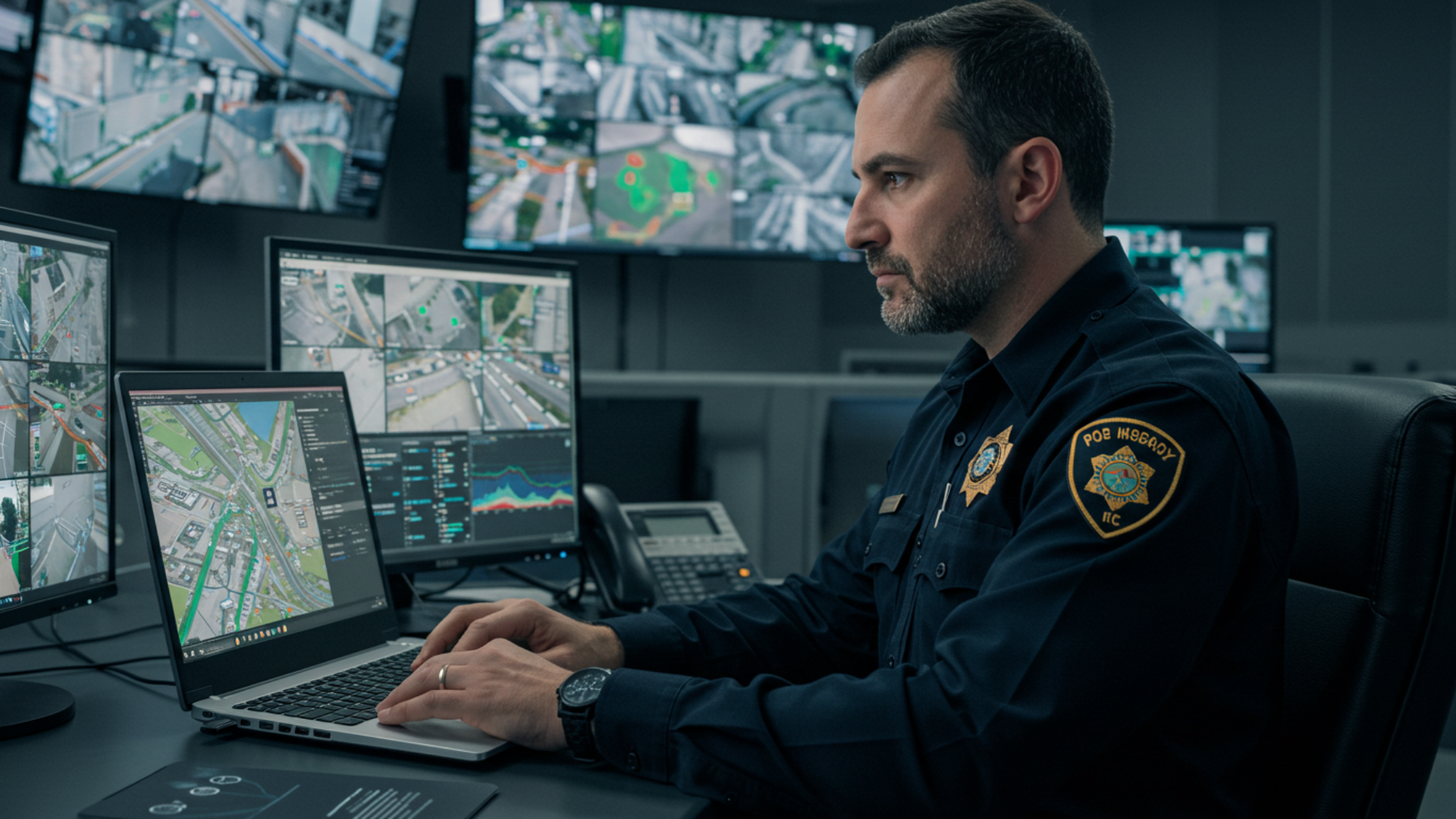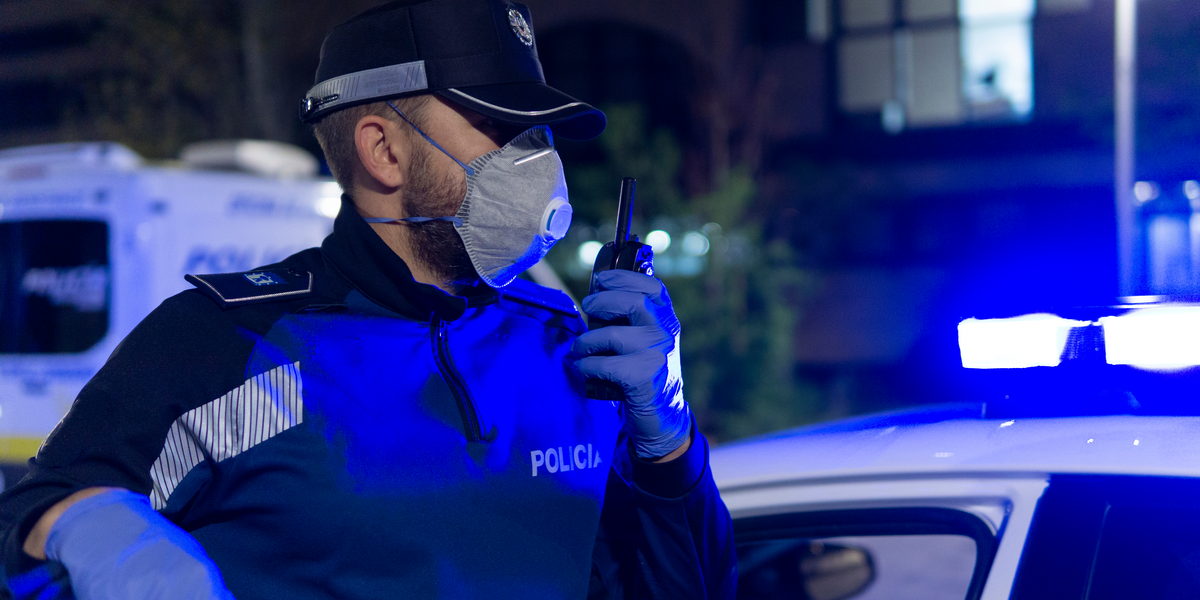Top 10 Public Safety Technologies to Look Out for in 2025
by Sarim Suleman, Last updated: March 17, 2025, Code:

The world of public safety technology is evolving at an unprecedented pace. As crime becomes more sophisticated and digital evidence continues to grow exponentially, law enforcement agencies and security organizations are turning to AI-powered solutions to stay ahead. The fusion of artificial intelligence, automation, and real-time analytics is revolutionizing how crimes are investigated, emergencies are managed, and security threats are detected.
From AI-driven surveillance and predictive analytics to automated evidence processing and crime mapping, emerging technologies are enabling law enforcement to respond faster, analyze smarter, and protect communities more effectively than ever before. The rise of machine learning, IoT, and cloud-based solutions is ensuring that agencies can harness data-driven intelligence to improve public safety operations.
In this blog, we explore the top 10 public safety technologies to watch in 2025. From AI-powered redaction and facial attribute prediction to automated video summarization and anomaly detection, these innovations are set to redefine law enforcement, digital forensics, and emergency response, making communities safer and security operations more efficient.
What is Public Safety Technology?
Public safety technology refers to the advanced tools and systems used to enhance safety, security, and emergency response in various sectors. It plays a crucial role in law enforcement, smart cities, and national security by improving operational efficiency, crime prevention, and disaster management.
Law enforcement agencies rely on public safety technology for digital evidence management, surveillance, and AI-powered analytics to streamline investigations.
Additionally, smart cities integrate public safety technology through AI-powered video surveillance, IoT-connected sensors, and predictive analytics to detect threats and improve urban security. National security agencies leverage cybersecurity solutions, drone surveillance, and biometric authentication to protect critical infrastructure and prevent security breaches.
The digital transformation of public safety agencies has become essential for improving efficiency, data-driven decision-making, and compliance with regulatory standards. Cloud-based solutions, AI automation, and secure digital evidence management platforms ensure seamless operations while maintaining data integrity and accessibility.
As crime patterns evolve and security threats become more sophisticated, investing in cutting-edge public safety technology is vital for creating safer communities, enhancing emergency preparedness, and ensuring rapid response to critical incidents.
One striking example is the case of Jaswant Singh Chail, who infiltrated Windsor Castle armed with a crossbow with a goal to assassinate the Queen. What makes this case alarming is how he used AI-powered chatbots, including ChatGPT and Replika, to refine his plan, seek emotional validation, and reinforce his intent. This incident demonstrates how criminals are leveraging technology in new ways, making it critical for law enforcement to adopt AI-driven tools.
Top 10 Public Safety Technologies to Watch in 2025
The rapid advancement of artificial intelligence (AI) and the Internet of Things (IoT) is reshaping the landscape of public safety technology, enabling faster decision-making, advanced analytics, and automated detection. As law enforcement agencies, emergency responders, and national security organizations face increasingly complex challenges, the integration of smart technologies has become essential for enhancing safety, security, and operational efficiency.
AI-driven automation is already proving its value in public safety. In New Orleans, AI-powered analytics are helping authorities process evidence from over 325 surveillance cameras, providing relevant video insights in 70% of cases and saving law enforcement more than 2,000 hours of manual work. This highlights how AI is reducing investigative burdens, allowing agencies to allocate resources more efficiently and respond to crime faster.
In 2025, public safety technology will continue to evolve, focusing not just on software innovations but also on advanced digital solutions designed to enhance surveillance, evidence management, and crisis response. As law enforcement agencies accumulate vast amounts of digital evidence from body-worn cameras, CCTV footage, and other sources, the real challenge is not just collecting data but making sense of it. The emphasis will shift toward AI-driven analytics to extract meaningful insights, streamline investigations, and accelerate efficient crime resolution.
As public safety operations evolve alongside the increasing sophistication of crimes, staying ahead of emerging technologies has become a necessity for law enforcement, government agencies, and security professionals committed to protecting communities in an increasingly unpredictable world.
Let us now explore the Top 10 public safety technologies that will revolutionize public safety operations in 2025.
1. Automated Evidence Ingestion and Integration
With the surge in public safety hardware, from body-worn cameras and dashcams to drones and IoT-enabled surveillance, law enforcement agencies are generating an unprecedented volume of digital evidence. However, managing this data manually is inefficient and time-consuming.
Automated evidence ingestion is transforming how agencies handle digital case files. This technology ensures that evidence from various sources is seamlessly collected, organized, and stored in a centralized system without human intervention. Automatic ingestion eliminates manual uploads, reducing errors and improving efficiency in digital evidence management.
The integration of Computer-Aided Dispatch (CAD) and Records Management Systems (RMS) further enhances this process and will continue to do in 2025 as well. Evidence can be automatically linked to case files, providing officers with real-time access to relevant digital assets.
With API-driven interoperability, this technology enables law enforcement agencies to customize workflows, ensuring that every piece of evidence is accurately logged, securely stored, and readily available for investigations.
By eliminating bottlenecks in evidence ingestion and integration, this technology enhances investigative speed, improves accuracy, and supports a more data-driven approach to public safety operations.
2. AI-Powered Evidence Tagging and Search
With the explosion of digital evidence from body-worn cameras, surveillance footage, mobile devices, and drone feeds, law enforcement agencies face a daunting challenge of how to efficiently sort, classify, and retrieve relevant information. AI-powered evidence tagging and search is revolutionizing this process, transforming raw digital files into structured, easily searchable assets.
This technology leverages machine learning and natural language processing (NLP) to automatically generate metadata for each piece of evidence. AI analyzes video, audio, images, and documents to detect faces, objects, license plates, speech, and text, assigning searchable tags without manual intervention. This ensures that investigators can instantly locate specific files through advanced keyword, facial recognition, and object-based searches.
What makes this breakthrough even more powerful is its ability to contextually link related evidence. Instead of sifting through hours of footage or thousands of images, AI can surface relevant case files, highlight patterns, and even identify connections between different pieces of evidence, enhancing both speed and accuracy in investigations.
By eliminating time-intensive manual cataloging, AI-powered tagging and search is redefining how law enforcement agencies manage digital evidence, making case resolution faster, smarter, and more efficient in the era of data-driven policing.
3. Geospatial Mapping of Digital Evidence
The rise of drones and IoT-enabled surveillance has transformed how law enforcement agencies collect and analyze digital evidence. One of the most groundbreaking advancements is geospatial mapping, which enables investigators to visualize evidence in a real-world location-based context for enhanced situational awareness.
A key technology driving this innovation is KLV (Key-Length-Value) metadata, which embeds geospatial coordinates, altitude, speed, and time into drone-captured video footage. This allows agencies to track suspect movements, reconstruct crime scenes, and synchronize multiple evidence sources with precise location data.
By integrating drone surveillance with geospatial analytics, law enforcement can create a comprehensive crime scene overview, identifying patterns, hotspots, and critical areas of interest. This capability is especially valuable in search-and-rescue operations, accident investigations, and tracking fugitives across large or complex terrains.
With geospatial mapping, digital evidence is no longer just static data but an interactive intelligence tool, allowing authorities to connect the dots between multiple locations, events, and investigative findings with greater speed and accuracy.
4. Frame-by-Frame Video Evidence Analysis for Investigations
With the increasing volume of surveillance and body-worn camera footage, manually reviewing video evidence is no longer practical. AI-powered frame-by-frame video analysis technology is transforming public safety by automatically detecting critical moments within lengthy recordings.
This technology utilizes computer vision and deep learning algorithms to analyze individual frames, identifying faces, objects, weapons, and vehicle license plates with precision. AI-driven motion tracking further enhances investigations by pinpointing suspicious activities or anomalies within a scene, allowing investigators to focus on high-priority segments.
Additionally, optical character recognition (OCR) enables text extraction from video frames, making street signs, license plates, and documents visible within the footage fully searchable. By automating video evidence analysis, law enforcement agencies can accelerate case resolution, improve accuracy, and ensure no critical detail is overlooked.
5. AI-Driven Summarization and Chaptering
The overwhelming amount of digital evidence in video form creates a significant bottleneck for investigators. AI-driven video summarization and chaptering is solving this problem by automatically extracting key moments and structuring long footage into logical sections for faster review.
By leveraging machine learning and natural language processing (NLP), AI detects scene transitions, motion intensity, and key interactions, segmenting videos into searchable chapters. This enables investigators to navigate through lengthy recordings effortlessly, skipping irrelevant portions and focusing on crucial moments.
Moreover, speech-to-text transcription and keyword-based indexing allow investigators to search for specific words or phrases spoken in video evidence, further enhancing efficiency. Instead of spending hours reviewing footage, law enforcement can now quickly locate relevant clips, reconstruct events, and extract actionable intelligence.
By automating video analysis, AI-driven summarization and chaptering drastically reduce manual effort, making investigative workflows faster, more precise, and highly efficient in solving complex cases.
6. Anomaly Detection and Activity Recognition
As public safety technology advances, AI-powered anomaly detection is revolutionizing surveillance by identifying unusual activities, security threats, and suspicious behaviors. Using computer vision and deep learning algorithms, this technology analyzes crowd behavior, movement patterns, and environmental changes to detect anomalies that might indicate criminal intent or emergencies.
For instance, AI can flag detect unauthorized access to restricted areas or identify aggressive behavior in surveillance footage. By continuously learning from past data, these systems improve accuracy over time, reducing false alarms and providing law enforcement with reliable, actionable intelligence.
With the rise of smart cities and IoT-connected devices, anomaly detection is becoming an essential tool for proactive crime prevention. AI-powered surveillance can alert authorities before incidents escalate, enhancing response times and ensuring public safety with minimal human intervention.
With the advancements in public safety technology in 2025, AI-driven anomaly detection will play a critical role in crime prevention, crowd monitoring, and emergency response, making it one of the most indispensable public safety technologies of the future.
7. Facial Attribute Prediction Using AI
Facial recognition has long been a game-changer in public safety technology, but AI-powered facial attribute prediction is taking it a step further. Instead of just identifying a person, AI now analyzes facial characteristics such as age, gender, race, and even emotional state to enhance criminal profiling and investigations.
By leveraging deep learning and facial analytics, AI can extract key attributes from surveillance footage, body cameras, and forensic images, helping law enforcement build detailed suspect profiles. This technology is particularly valuable when a suspect's identity is unknown, as it allows authorities to narrow down search parameters and identify persons of interest more efficiently.
In high-risk areas like airports, stadiums, and government buildings, facial attribute prediction assists security teams in detecting potential threats based on behavioral and demographic patterns. As public safety technology continues to evolve, AI-powered facial analytics will remain a crucial tool in enhancing law enforcement investigations and ensuring national security.
8. AI-Powered Emotion Detection and Sentiment Analysis
In criminal investigations, understanding a suspect’s or victim’s emotional state can be just as important as the evidence itself. AI-powered emotion detection and sentiment analysis is transforming how law enforcement interprets human behavior by analyzing facial expressions, voice tone, and physiological signals.
This technology utilizes computer vision, speech analysis, and deep learning to assess emotions in interrogation videos, emergency calls, and surveillance footage. AI can detect fear, anger, sadness, or happiness, helping officers gauge whether a suspect is lying or withholding critical information.
Beyond criminal interrogations, emotion recognition is also enhancing emergency response systems. AI can analyze 911 calls to detect panic or urgency, enabling dispatchers to prioritize life-threatening situations more effectively. In large public events, it can monitor crowds for signs of distress or unrest, preventing potential security threats before they escalate.
With major technological advancements across all sectors in 2025, AI-powered emotion detection is set to become one of the most valuable public safety technologies, enabling law enforcement and emergency responders to make more accurate, data-driven decisions.
By integrating AI-driven behavioral analysis, public safety agencies can enhance crime prevention, improve response times, and gain deeper insights into criminal intent, reshaping the future of security and law enforcement worldwide.
9. AI Chatbots for Public Safety
AI-powered chatbots are emerging as a critical tool in public safety technology, transforming the way law enforcement agencies, emergency responders, and public safety organizations interact with citizens. These chatbots use natural language processing (NLP) and machine learning to provide instant communication, crisis management, and automated reporting, reducing response times and improving accessibility.
For law enforcement, chatbots streamline investigative workflows by answering officers' queries regarding legal procedures, case updates, and internal protocols. They also assist in suspect interviews by generating dynamic, AI-driven question prompts based on real-time conversational data.
In public safety awareness, AI chatbots play a crucial role in community engagement by sending out automated alerts, safety instructions, and crime prevention tips to residents in high-risk areas. With their ability to process large volumes of inquiries simultaneously, chatbots are revolutionizing crisis communication, law enforcement efficiency, and citizen interaction in 2025.
10. AI-Powered Redaction for Safeguarding Privacy in Digital Evidence
As the volume of digital evidence continues to grow, protecting sensitive information has become not just a priority but a critical requirement in today’s digital age for law enforcement agencies and public safety organizations. AI-powered redaction is revolutionizing how agencies automatically detect and remove personally identifiable information (PII) from video, audio, images, and documents, ensuring compliance with privacy laws and evidence disclosure regulations.
The foundation of AI redaction lies in object detection and tracking, which allows the system to automatically detect faces, license plates, and other sensitive details in video footage. Advanced AI models ensure that once an object is identified, it remains redacted even as it moves across frames, maintaining accuracy and consistency.
Another key capability is OCR-based redaction, which enables AI to detect and blur text in images and scanned documents. Whether it's license plates, identification numbers, or confidential documents, OCR technology ensures sensitive data is removed before evidence is shared or disclosed.
For audio and video evidence, transcript-based redaction is a game-changer. AI first transcribes the spoken content, converting speech into text. It then automatically detects and redacts sensitive words, names, or phrases from the transcription, ensuring both the visual and textual versions of the evidence remain secure.
An advanced feature of AI-powered redaction is spoken PII redaction, where AI automatically detects and mutes sensitive words within an audio recording, eliminating the need for manual review. This technology ensures compliance with the Freedom of Information Act (FOIA), court orders, and privacy regulations while preventing delays in legal proceedings.
With AI-powered redaction, public safety agencies can efficiently process, analyze, and share digital evidence while maintaining compliance, privacy protection, and operational efficiency—making it one of the most vital public safety technologies of 2025. As digital technology advances and public awareness of privacy rights grows, the demand for AI-driven redaction solutions has surged. This technology has now become an indispensable tool in public safety, helping agencies manage the increasing volume of FOIA requests while ensuring sensitive data remains protected.
How VIDIZMO Digital Evidence Management System Powers Public Safety Technology
With public safety technology rapidly evolving in 2025, the need for AI-driven evidence management solutions has never been greater. As law enforcement agencies and public safety organizations generate massive volumes of digital evidence, VIDIZMO Digital Evidence Management System (DEMS) emerges as a leading AI-powered solution designed to automate, secure, and streamline evidence workflows. It integrates AI-powered search, automated ingestion, metadata tagging, and frame-by-frame video analysis, ensuring investigators can quickly access and process critical digital evidence without delays.
Incorporating geospatial mapping and AI-driven anomaly detection, VIDIZMO DEMS enhances crime scene investigations by linking evidence to real-world locations and detecting unusual activities in surveillance footage. AI-powered summarization and chaptering further accelerate investigations by automatically extracting key moments from hours of video. To ensure compliance with privacy regulations, advanced redaction features, including OCR-based text redaction, transcript-based redaction, spoken PII redaction, and object detection protect sensitive information while enabling efficient evidence sharing.
With secure cloud storage, flexible deployment options, and end-to-end encryption, VIDIZMO DEMS ensures data integrity, chain of custody, and seamless interoperability with CAD and RMS systems. As AI, automation, and digital forensics continue to shape public safety technology in 2025, VIDIZMO DEMS remains at the forefront, providing law enforcement agencies with the tools they need to manage digital evidence efficiently and securely.
Stay ahead in the evolving landscape of public safety technology with the cutting-edge capabilities of VIDIZMO DEMS. Sign up for a 7-day free trial today or contact us to schedule your demo now!
The Future of Public Safety Technology
As crime evolves and security challenges become more complex, public safety technology continues to push boundaries, empowering law enforcement and emergency responders with AI-driven automation, advanced analytics, and real-time intelligence. The integration of machine learning, geospatial mapping, anomaly detection, and automated redaction is transforming how digital evidence is managed, analyzed, and utilized for effective crime prevention and investigation.
From AI-powered search and facial attribute prediction to automated video summarization and sentiment analysis, these innovations are reshaping law enforcement operations, allowing agencies to act faster, smarter, and with greater accuracy. The rapid adoption of these technologies is not just about efficiency; it is about building safer communities, ensuring justice, and adapting to the ever-changing landscape of public safety.
As 2025 progresses, embracing the latest advancements in public safety technology will be crucial for organizations looking to enhance security, streamline investigations, and stay ahead of emerging threats. Those who leverage these cutting-edge tools will set the new standard for data-driven, AI-enhanced public safety solutions, making the world a safer and more connected place for all.
People Also Ask
How is technology used in public safety?
Technology is transforming public safety by enabling law enforcement and emergency responders to work more efficiently and effectively. AI-powered surveillance, predictive analytics, IoT-connected sensors, and data processing help agencies prevent crimes, manage digital evidence, and respond to emergencies faster. Cloud-based solutions and automated redaction tools ensure secure and compliant evidence handling.
What challenges do states face in ensuring public safety?
States face multiple challenges in ensuring public safety, including rising crime rates, cyber threats, resource constraints, and managing massive volumes of digital evidence. Ensuring data security, compliance with privacy regulations, and seamless integration of new technologies into existing infrastructure is also a key concern.
What are the latest public safety technologies in 2025?
Some of the most advanced public safety technologies in 2025 include AI-powered evidence management, real-time anomaly detection, geospatial crime mapping, automated redaction tools, and AI-driven surveillance analytics. These innovations help law enforcement agencies enhance investigations, improve response times, and ensure data-driven decision-making in public safety operations.
How does AI improve public safety?
Artificial Intelligence (AI) improves public safety by automating digital evidence processing, detecting criminal activity in real time, and analyzing large datasets to identify crime patterns. AI-powered facial recognition, anomaly detection, and emotion analysis assist in suspect identification, security screening, and crisis response, making investigations faster and more precise.
How does geospatial mapping help in law enforcement?
Geospatial mapping provides law enforcement with real-time crime scene visualization by integrating drone footage, CCTV surveillance, and GPS data. This technology helps officers track suspect movements, map crime hotspots, and enhance search-and-rescue operations, improving situational awareness and decision-making.
What role does AI-powered redaction play in public safety?
AI-powered redaction ensures privacy protection and compliance by automatically removing personally identifiable information (PII) from video, audio, images, and documents. Advanced AI models enable OCR-based redaction, transcript-based redaction, and spoken PII redaction, making digital evidence secure for legal proceedings, FOIA requests, and public disclosures.
Jump to
You May Also Like
These Related Stories

How Law Enforcement Digital Evidence Management Is Transforming Data

10 Essential Features of Law Enforcement Digital Evidence Management Solution



No Comments Yet
Let us know what you think